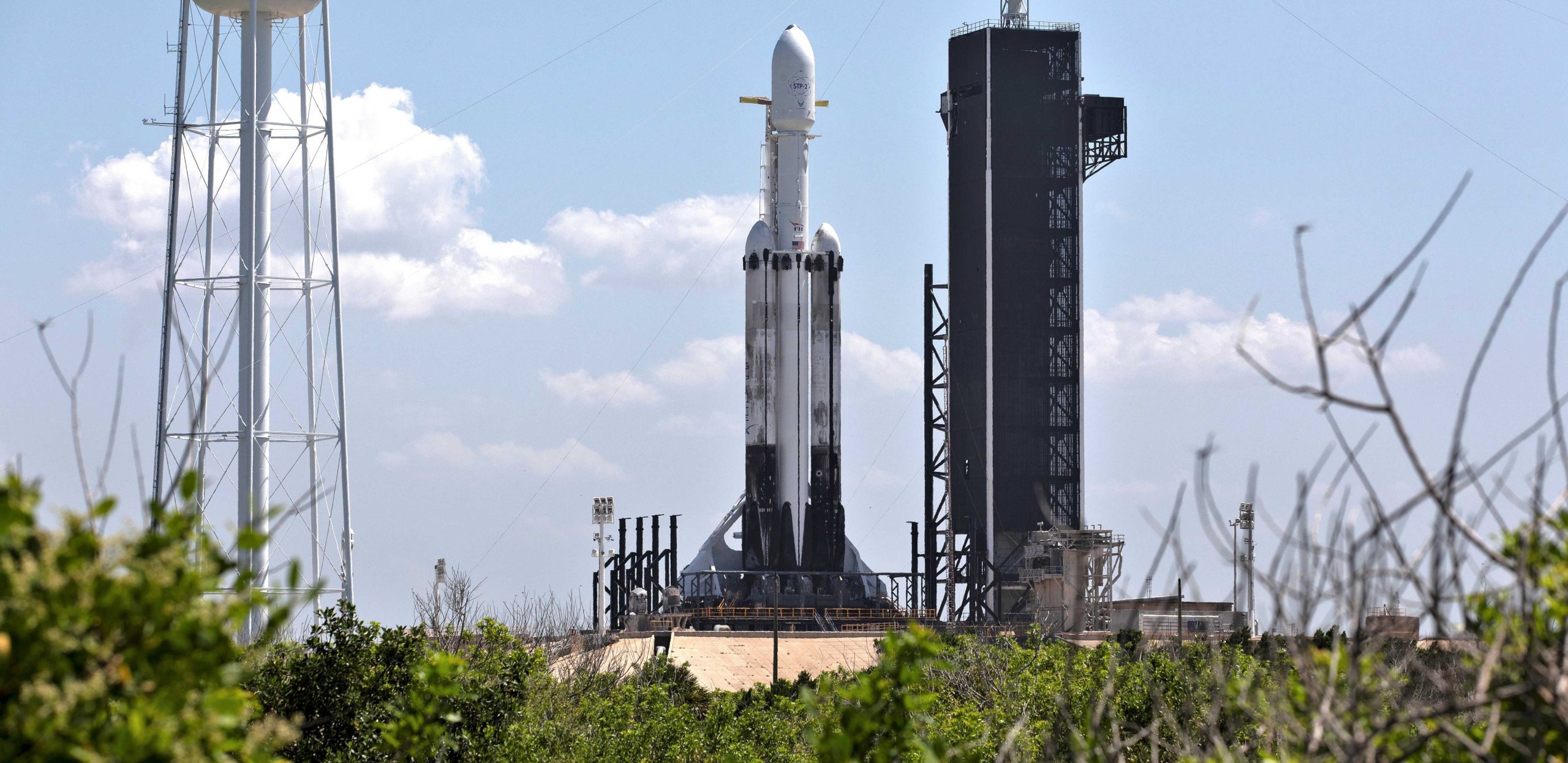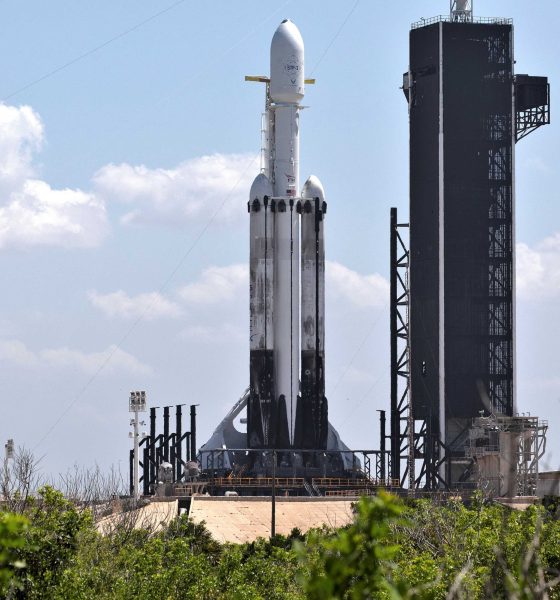

News
SpaceX to launch Falcon Heavy rocket 3 times in 6 months after latest payload delay
For at least the second time in 2021, unspecified issues with a US military payload have delayed SpaceX’s next Falcon Heavy launch, this time pushing the mission into next year.
Known as USSF-44 (formerly AFSPC-44), the US Air Force (now Space Force) contracted a SpaceX Falcon Heavy rocket in February 2019 to launch the classified payload for roughly $150M in fiscal year 2021 (no earlier than Q4 2020). Gradually, USSF-44 slipped without explanation to Q2 2021, at which point SpaceX had fully qualified and delivered all three new Falcon Heavy boosters and an expendable upper stage for the mission. After two more slips to July and October 2021, a US military official finally offered the first hint of an explanation for what now amounted to a full year of delays, explaining that USSF-44 had been pushed into Q4 “to accommodate payload readiness.”
Translated from US military doublespeak and euphemism, the manufacturer (likely Lockheed Martin, Northrop Grumman, or Boeing) building USSF-44’s classified payload(s) ran into or create issues that caused at least 3-6 months of delays. Now, per official comments obtained from a Space Force spokesperson by Spaceflight Now, USSF-44 has again been delayed several months “to accommodate payload readiness,” pushing Falcon Heavy’s fourth launch ever from October 2021 to no earlier than (NET) Q1 2022.
USSF-44’s latest delay means that SpaceX is now likely to go a full 30 months between Falcon Heavy flights after completing the rocket’s third and most recent launch in June 2019. The slip to “early 2022” also leaves the company with an extremely ambitious launch manifest in the first half of 2022. Barring one or several significant delays, which now seems like the most plausible outcome, SpaceX has four major Falcon Heavy missions – USSF-44, USSF-52, ViaSat-3, and NASA’s Psyche probe – scheduled to launch set to launch by August, with three of the four scheduled in H1 2022. A fifth mission – USSF-67 – is scheduled to launch in Q4 2022 and likely on another Falcon Heavy rocket, though the US military has yet to specify the Falcon variant.
Further, requiring the use of the same Kennedy Space Center (KSC) LC-39A pad, SpaceX also has at least six Crew and Cargo Dragon launches scheduled in February (Ax-1), April (Crew-4), May (CRS-25), Q3 (Ax-2), September (CRS-26), and October 2022 (Crew-5). In other words, in Dragon and Falcon Heavy missions alone, SpaceX already has 10-11 launches scheduled in 2022 – all of which require the use of Pad 39A. If SpaceX manages to pull that off on top of a myriad of other commercial and Starlink launches scheduled next year, it will be a feat to remember.
Barring additional delays, USSF-44 will be SpaceX’s first direct launch to geostationary orbit (GEO), requiring the Falcon upper stage to survive a multi-hour coast through and inside two radiation belts before reigniting for a circularization burn some 35,800 km (22,300 mi) above Earth’s surface. However, a rideshare payload transferred to SpaceX’s ViaSat-3 communications satellite launch recently revealed that SpaceX also intends to send those payloads directly to GEO in Q2 2022, meaning that another few months could force the company to leapfrog USSF-44.
For now, fans of the most powerful operational rocket in the world will have to wait at least another three months for its next launch.

News
Tesla Cybercab tests are going on overdrive with production-ready units
Tesla is ramping its real-world tests of the Cybercab, with multiple sightings of the vehicle being reported across social media this week.

Tesla is ramping its real-world tests of the Cybercab, with multiple sightings of the autonomous two-seater being reported across social media this week. Based on videos of the vehicle that have been shared online, it appears that Cybercab tests are underway across multiple states.
Recent Cybercab sightings
Reports of Cybercab tests have ramped this week, with a vehicle that looked like a production-ready prototype being spotted at Apple’s Visitor Center in California. The vehicle in this sighting was interesting as it was equipped with a steering wheel. The vehicle also featured some changes to the design of its brake lights.
The Cybercab was also filmed testing at the Fremont factory’s test track, which also seemed to involve a vehicle that looked production-ready. This also seemed to be the case for a Cybercab that was spotted in Austin, Texas, which happened to be undergoing real-world tests. Overall, these sightings suggest that Cybercab testing is fully underway, and the vehicle is really moving towards production.
Production design all but finalized?
Recently, a near-production-ready Cybercab was showcased at Tesla’s Santana Row showroom in San Jose. The vehicle was equipped with frameless windows, dual windshield wipers, powered butterfly door struts, an extended front splitter, an updated lightbar, new wheel covers, and a license plate bracket. Interior updates include redesigned dash/door panels, refined seats with center cupholders, updated carpet, and what appeared to be improved legroom.
There seems to be a pretty good chance that the Cybercab’s design has been all but finalized, at least considering Elon Musk’s comments at the 2025 Annual Shareholder Meeting. During the event, Musk confirmed that the vehicle will enter production around April 2026, and its production targets will be quite ambitious.
News
Tesla gets a win in Sweden as union withdraws potentially “illegal” blockade
As per recent reports, the Vision union’s planned anti-Tesla action might have been illegal.

Swedish union Vision has withdrawn its sympathy blockade against Tesla’s planned service center and showroom in Kalmar. As per recent reports, the Vision union’s planned anti-Tesla action might have been illegal.
Vision’s decision to pull the blockade
Vision announced the blockade in early December, stating that it was targeting the administrative handling of Tesla’s facility permits in Kalmar municipality. The sympathy measure was expected to start Monday, but was formally withdrawn via documents sent to the Mediation Institute and Kalmar Municipality last week.
As noted in a Daggers Arbete report, plans for the strike were ultimately pulled after employer group SKR highlighted potential illegality under the Public Employment Act. Vision stressed its continued backing for the Swedish labor model, though Deputy negotiation manager Oskar Pettersson explained that the Vision union and IF Metall made the decision to cancel the planned strike together.
“We will not continue to challenge the regulations,” Petterson said. “The objection was of a technical nature. We made the assessment together with IF Metall that we were not in a position to challenge the legal assessment of whether we could take this particular action against Tesla. Therefore, we chose to revoke the notice itself.”
The SKR’s warning
Petterson also stated that SKR’s technical objection to the Vision union’s planned anti-Tesla strike framed the protest as an unauthorized act. “It was a legal assessment of the situation. Both for us and for IF Metall, it is important to be clear that we stand for the Swedish model. But we should not continue to challenge the regulations and risk getting judgments that lead nowhere in the application of the regulations,” he said.
Vision ultimately canceled its planned blockade against Tesla on December 9. With Vision’s withdrawal, few obstacles remain for Tesla’s long-planned Kalmar site. A foreign electrical firm completed work this fall, and Tesla’s Careers page currently lists a full-time service manager position based there, signaling an imminent opening.
News
Tesla Semi program Director teases major improvements

Tesla Semi Program Director Dan Priestly teased the major improvements to the all-electric Class 8 truck on Thursday night, following the company’s decision to overhaul the design earlier this year.
Priestley said he drove the Semi on Thursday, and the improvements appear to be welcomed by one of the minds behind the project. “Our customers are going to love it,” he concluded.
Just drove the redesigned Semi. Our customers are going to love it. https://t.co/KZ88sf1CDL
— Dan Priestley (@danWpriestley) December 19, 2025
The small detail does not seem like much, but it is coming from someone who has been involved in the development of the truck from A to Z. Priestley has been involved in the Semi program since November 2015 and has slowly worked his way through the ranks, and currently stands as the Director of the program.
Tesla Semi undergoes major redesign as dedicated factory preps for deliveries
Tesla made some major changes to the Semi design as it announced at the 2025 Annual Shareholder Meeting that it changed the look and design to welcome improvements in efficiency.
Initially, Tesla adopted the blade-like light bar for the Semi, similar to the one that is present on the Model Y Premium and the Cybertruck.
Additionally, there are some slight aesthetic changes to help with efficiency, including a redesigned bumper with improved aero channels, a smaller wraparound windshield, and a smoother roofline for better aero performance.
All of these changes came as the company’s Semi Factory, which is located on Gigafactory Nevada’s property, was finishing up construction in preparation for initial production phases, as Tesla is planning to ramp up manufacturing next year. CEO Elon Musk has said the Semi has attracted “ridiculous demand.”
The Semi has already gathered many large companies that have signed up to buy units, including Frito-Lay and PepsiCo., which have been helping Tesla test the vehicle in a pilot program to test range, efficiency, and other important metrics that will be a major selling point.
Tesla will be the Semi’s first user, though, and the truck will help solve some of the company’s logistics needs in the coming years.








